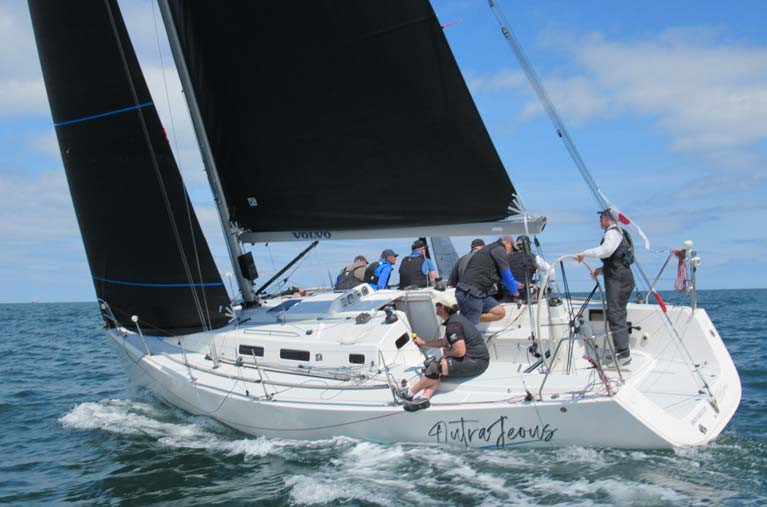Barry Hayes from UK Sailmakers Ireland gives his top ten sail trim tips for the coming season
1. Know your sails, know your settings
Many boats sailing inshore with non-overlapping headsail setup regularly use up to three headsails. It is vital that you have go-to settings for each sail. I assign a colour to each sail, green for J1, blue for J2, red for J3. I then whip a mark on my jib car adjustment line in each colour, on both sides, so I have a good starting point for each sail. This is particularly helpful if you have been reaching and the car went forward, or if the wrong rope was uncleated at the windward mark, you have a quick reference point in the cockpit go to.
Pre-set markings also should be made on the jib halyard using a scale on the deck in front of the halyard clutch. Set each sail to good halyard tension (looking at the draft position of the sail) and mark the scale with the sail’s corresponding colour.
These will give you baselines to work from for each sail that you can tweak as conditions require and will allow anyone to step into the pit and easily set-up the baselines.
2. What is Twist?
Twist, in its raw form, is the difference in your sails “angle of incidence” when measured at points of increasing height up the sail’s leech. Twist is when the top of the sail opens compared to the lower sections. We increase twist in light winds and take out twist as the wind increases. This also has a lot to do with how the wind is performing at various heights. Friction from the water slows downwind on the lower portions of the sail relative to wind further aloft. The lower, relatively slower wind changes the angle of the different than higher sections, so we need to twist our sails to make sure they are trimmed correctly in up and down the entire sail. This is particularly important in lighter conditions where the wind angles up the sail vary more than in heavier conditions.
It is fundamental to understand that twist gives us the ability to control the lift and drag produced by our sails. As the wind speed increases and the surface friction has less of an effect on the wind angle, there ends up being less difference between the top and bottom of the sail. As such, less twist is needed to trim the sail correctly.
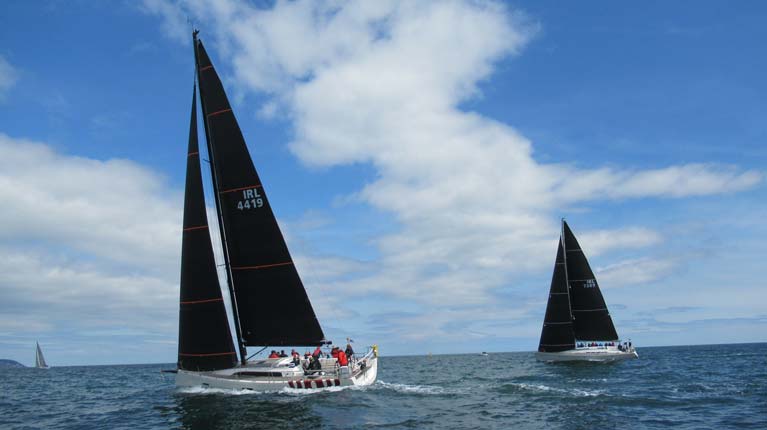
3. Watch those telltales…
.. but not the ones you may think. The headsail luff telltales are a great indication of where the sail is in terms of power and car position, but, when sailing upwind, the leech telltales are absolutely crucial as they show how close you are to max trim. Unlike the mainsail, where some stall is good, we want as little stall as possible on the leech of the jib; but we want to be right on the edge, as close to stalling as possible. Our leech telltales are the best indicator of this.
Generally, your top leech telltale will stall first. Trim the sheet until the top telltale starts to fall to leeward. It is being sucked into the leech by the air separating off the leeward side of the sail. Once you have this stall, ease the sheet a touch to get the telltale flowing 95% of the time with a 5% stall. This is a good indicator that the jib is fully trimmed for average conditions.
If the conditions allow it, stay to leeward and check this constantly. If the breeze drops, the sail will stall so ease the sheet. If a puff hits, the sail becomes under-trimmed and, always looking for that little bit of telltale stall, trim the sheet as necessary.
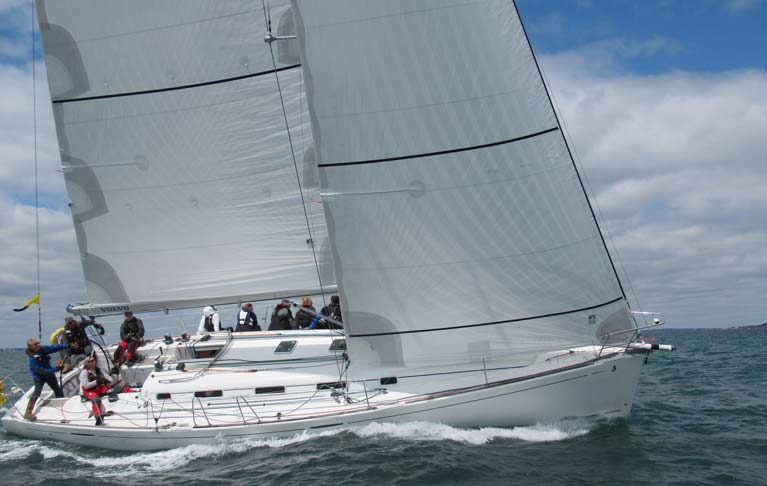
4. Ease your inhaulers during pre-start
If you have a boat with a non-overlapping jib trimmed through inhaulers, this tip is for you! When you are manoeuvring during the pre-start, make sure your inhaulers are fully eased. Inhaulers are a great tool for improved trim, but only when sailing fully upwind. When reaching or bearing away during pre-start, it is important to keep the boat at maximum power and speed (when needed). If you inhaulers are trimmed inboard, your jib will twist open when the sheet is eased, the inhauler will hold the clew inboard, leaving the bottom of the sail over trimmed and sacrificing power. Only trim the inhaulers to your marked upwind setting on your final approach to the line.
5. Keep an eye on the “big” sail
Mainsails on cruising and racing boats have evolved into much bigger sails. On racing boats, the main has grown because of rating advantages, while the mains on cruising boats have grown so that they can be sailed under main alone.
Luckily, methods for trimming the mainsail are virtually identical for all boats, fractional or masthead, racing or cruising. The cunningham, backstay, outhaul and running backstays are all used for the same purposes.
Upwind mainsail trim breaks down into three basic modes: Maximum Point, Cruising Speed, and Fast Forward (I’ll discuss Fast Forward in the following tip and the others in future articles). Cruising speed is used 90 per cent of the time when sailing upwind, while max point and fast forward modes are saved for particular tactical situations. For the following tips, I'm assuming the jib/genoa is trimmed properly.
Sailing upwind is the slowest point of sailing; therefore, small differences in heading and boat speed are significant. For racers, upwind sailing is critical because most races start with the first leg into the wind.
6. Fast Forward
I call the third setting for upwind sailing the Fast Forward mode. This mode is useful in several tactical situations such as when you have over-stood the weather mark, or when you are trying to reach over the top of the fleet in anticipation of the next header. Another condition is if you have come off the starting line and have just a slight advantage over the boats leeward of you and you want to foot down over the top of another boat causing it to tack.
As in all settings, the jib should be set properly for beating with, perhaps its outside telltales lifting slightly applying more pressure on the genoa and generating a few extra tenths of boat speed.
Set the mainsail with the maximum depth it can carry without excessive heel and without stalling the leech. Do this with the cunningham and outhaul while keeping the boom on centreline and ease the main sheet and the vang slightly allowing the boom to lift and twist off the top two battens. If your boat has them, ease the runners to twist the main slightly. Your speed will continue to rise.

7. Trim
“If in doubt – ease it out” There is nothing slower than an over trimmed spinnaker. Always ease the sheet so the luff of the sail is showing a slight curl. If the curl becomes too big and is threatening to collapse the spinnaker, trim in to stabilise the sail.
This is the foundation of good spinnaker trim. A slight curl means the sail is producing max power with minimal stall. From there, your sheet should be trimmed in and out a few inches constantly. The spinnaker trimmer has no time to look around and take in the sights downwind, it is a constant job. Always be checking if you are at the point of curl. If the sheet isn’t moving then the spinnaker isn’t being trimmed. Small subtle adjustments to keep you at top speed.
8. Symmetrical Spinnaker Fore & Aft Trim
Once your sheet is eased and spinnaker showing signs of curling, we can now look at our fore/aft spinnaker pole trim. This is adjusted using the guy and foreguy.

The objective is to make the vertical mid seam of your spinnaker parallel to the mast, i.e. vertical. When this seam is vertical your fore/aft pole trim is correct.
If the mid seam is angled to windward, trim your pole aft which will make the seam vertical again.
If the centre seam is angled towards the mast , ease the pole forward until the seam is vertical once again.
The guy should be trimmed about half as much as the sheet with the foreguy adjusted accordingly. The guy trimmer should listen to the sheet trimmer and always work together as too much “unauthorized” pole adjustment will confuse your sheet trimmer.
9. Pole Height
Optimum pole height is determined by where your spinnaker curl begins. Easing the spinnaker sheet should create a curl at the mid-section of the luff that will then spread evenly up and down from this point.
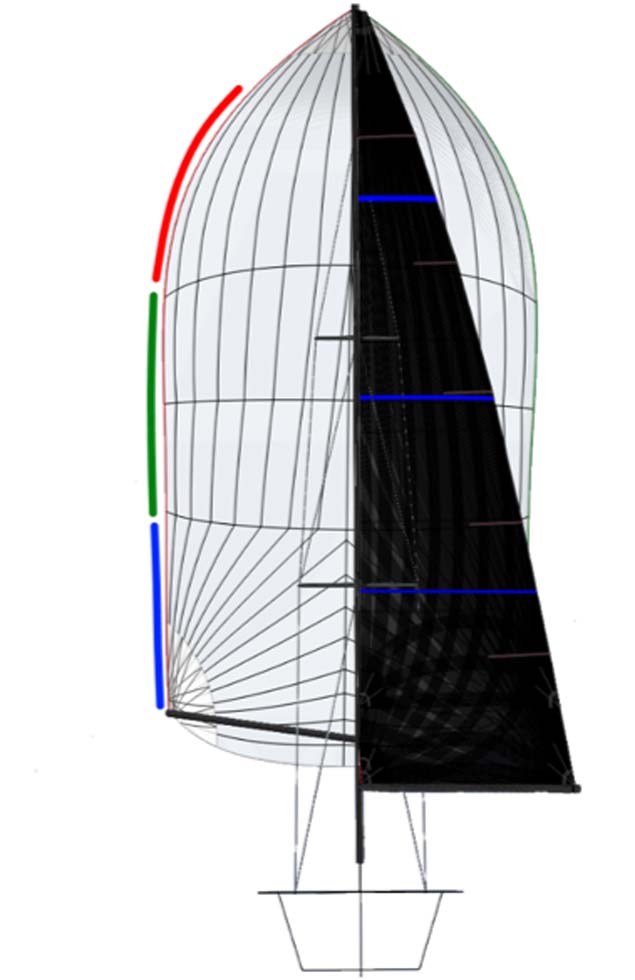
If the curl begins above the middle section (towards the head) then the outboard end of your pole is too low. If the curl begins lower than the middle section (towards the clew) then the pole end is too high. Adjust inboard and outboard pole hight until the curl starts at the middle section.
10. Forces Sailing Downwind
As the breeze freshens, it’s important to understand the forces being generated by your downwind sails – the mainsail force and spinnaker force combine and determine where the boat is going. The goal is to have these combined forces align with your course.
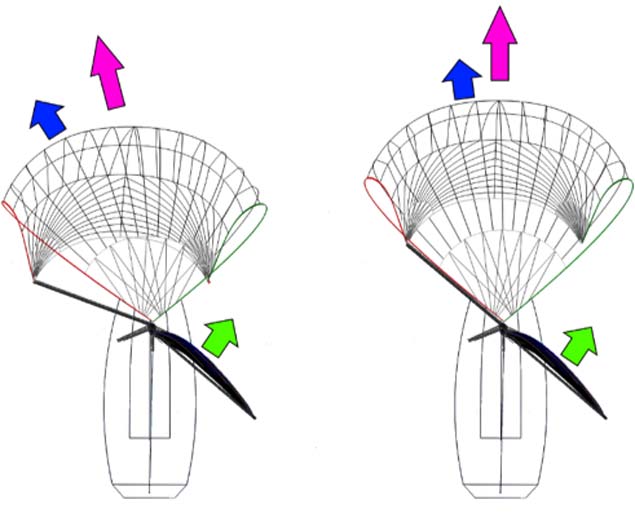
We have all experienced the unsettling rolling motion when sailing downwind in breeze – in extreme cases, this can result in a broach gybe. This rolling is caused by pole being too far aft. The spinnaker force overpowers the mainsail force – causing the spinnaker to pull the boat to windward. Ease the pole forward which realigns the spinnaker force and brings the boat back into balance.



























